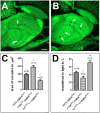Increased actin polymerization and stabilization interferes with neuronal function and survival in the AMPKγ mutant Loechrig
- PMID: 24587072
- PMCID: PMC3934941
- DOI: 10.1371/journal.pone.0089847
Increased actin polymerization and stabilization interferes with neuronal function and survival in the AMPKγ mutant Loechrig
Abstract
loechrig (loe) mutant flies are characterized by progressive neuronal degeneration, behavioral deficits, and early death. The mutation is due to a P-element insertion in the gene for the γ-subunit of the trimeric AMP-activated protein kinase (AMPK) complex, whereby the insertion affects only one of several alternative transcripts encoding a unique neuronal isoform. AMPK is a cellular energy sensor that regulates a plethora of signaling pathways, including cholesterol and isoprenoid synthesis via its downstream target hydroxy-methylglutaryl (HMG)-CoA reductase. We recently showed that loe interferes with isoprenoid synthesis and increases the prenylation and thereby activation of RhoA. During development, RhoA plays an important role in neuronal outgrowth by activating a signaling cascade that regulates actin dynamics. Here we show that the effect of loe/AMPKγ on RhoA prenylation leads to a hyperactivation of this signaling pathway, causing increased phosphorylation of the actin depolymerizating factor cofilin and accumulation of filamentous actin. Furthermore, our results show that the resulting cytoskeletal changes in loe interfere with neuronal growth and disrupt axonal integrity. Surprisingly, these phenotypes were enhanced by expressing the Slingshot (SSH) phosphatase, which during development promotes actin depolymerization by dephosphorylating cofilin. However, our studies suggest that in the adult SSH promotes actin polymerization, supporting in vitro studies using human SSH1 that suggested that SSH can also stabilize and bundle filamentous actin. Together with the observed increase in SSH levels in the loe mutant, our experiments suggest that in mature neurons SSH may function as a stabilization factor for filamentous actin instead of promoting actin depolymerization.
Conflict of interest statement
Figures










Similar articles
-
Increased RhoA prenylation in the loechrig (loe) mutant leads to progressive neurodegeneration.PLoS One. 2012;7(9):e44440. doi: 10.1371/journal.pone.0044440. Epub 2012 Sep 6. PLoS One. 2012. PMID: 22970217 Free PMC article.
-
Capulet and Slingshot share overlapping functions during Drosophila eye morphogenesis.J Biomed Sci. 2012 Apr 30;19(1):46. doi: 10.1186/1423-0127-19-46. J Biomed Sci. 2012. PMID: 22545588 Free PMC article.
-
The NAV2 homolog Sickie regulates F-actin-mediated axonal growth in Drosophila mushroom body neurons via the non-canonical Rac-Cofilin pathway.Development. 2014 Dec;141(24):4716-28. doi: 10.1242/dev.113308. Epub 2014 Nov 19. Development. 2014. PMID: 25411210
-
Signaling mechanisms and functional roles of cofilin phosphorylation and dephosphorylation.Cell Signal. 2013 Feb;25(2):457-69. doi: 10.1016/j.cellsig.2012.11.001. Epub 2012 Nov 12. Cell Signal. 2013. PMID: 23153585 Review.
-
Aβ Influences Cytoskeletal Signaling Cascades with Consequences to Alzheimer's Disease.Mol Neurobiol. 2015 Dec;52(3):1391-1407. doi: 10.1007/s12035-014-8913-4. Epub 2014 Oct 26. Mol Neurobiol. 2015. PMID: 25344315 Review.
Cited by
-
PP2A phosphatase regulates cell-type specific cytoskeletal organization to drive dendrite diversity.Front Mol Neurosci. 2022 Nov 14;15:926567. doi: 10.3389/fnmol.2022.926567. eCollection 2022. Front Mol Neurosci. 2022. PMID: 36452406 Free PMC article.
-
Overexpressed Down Syndrome Cell Adhesion Molecule (DSCAM) Deregulates P21-Activated Kinase (PAK) Activity in an In Vitro Neuronal Model of Down Syndrome: Consequences on Cell Process Formation and Extension.Neurotox Res. 2016 Jul;30(1):76-87. doi: 10.1007/s12640-016-9613-9. Epub 2016 Mar 10. Neurotox Res. 2016. PMID: 26966010
-
Analysis of Amyloid Precursor Protein Function in Drosophila melanogaster.Front Mol Neurosci. 2016 Jul 26;9:61. doi: 10.3389/fnmol.2016.00061. eCollection 2016. Front Mol Neurosci. 2016. PMID: 27507933 Free PMC article. Review.
-
Poria cocos Regulates Cell Migration and Actin Filament Aggregation in B35 and C6 Cells by Modulating the RhoA, CDC42, and Rho Signaling Pathways.Evid Based Complement Alternat Med. 2021 Sep 1;2021:6854860. doi: 10.1155/2021/6854860. eCollection 2021. Evid Based Complement Alternat Med. 2021. PMID: 34512781 Free PMC article.
-
Analysis of mitochondrial organization and function in the Drosophila blastoderm embryo.Sci Rep. 2017 Jul 14;7(1):5502. doi: 10.1038/s41598-017-05679-1. Sci Rep. 2017. PMID: 28710464 Free PMC article.
References
-
- Kemp BE, Mitchelhill KI, Stapleton D, Michell BJ, Chen ZP, et al. (1999) Dealing with energy demand: the AMP-activated protein kinase. Trends Biochem Sci 24: 22–25. - PubMed
-
- Steinberg GR, Kemp BE (2009) AMPK in Health and Disease. Physiol Rev 89: 1025–1078. - PubMed
-
- Hardie DG (2007) AMP-activated/SNF1 protein kinases: conserved guardians of cellular energy. Nat Rev Mol Cell Biol 8: 774–785. - PubMed
-
- Culmsee C, Monnig J, Kemp BE, Mattson MP (2001) AMP-activated protein kinase is highly expressed in neurons in the developing rat brain and promotes neuronal survival following glucose deprivation. J Mol Neurosci 17: 45–58. - PubMed
-
- Turnley AM, Stapleton D, Mann RJ, Witters LA, Kemp BE, et al. (1999) Cellular distribution and developmental expression of AMP-activated protein kinase isoforms in mouse central nervous system. J Neurochem 72: 1707–1716. - PubMed
Publication types
MeSH terms
Substances
LinkOut - more resources
Full Text Sources
Other Literature Sources
Molecular Biology Databases

